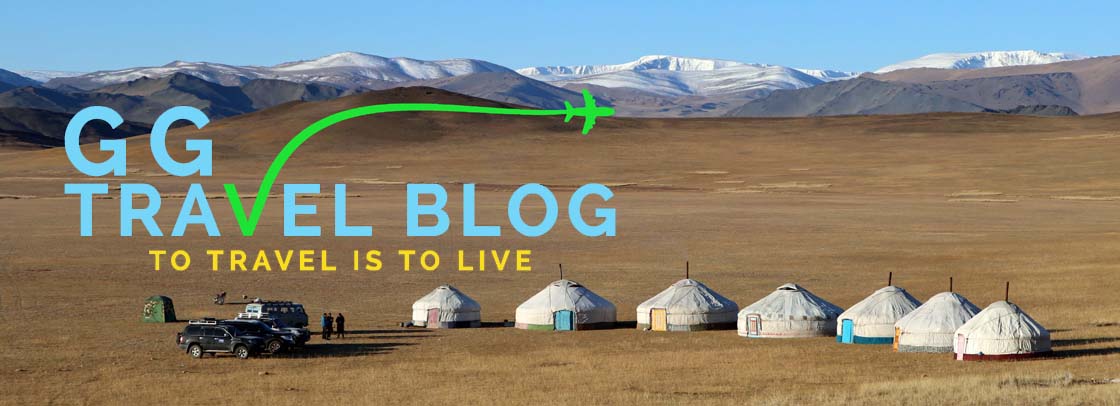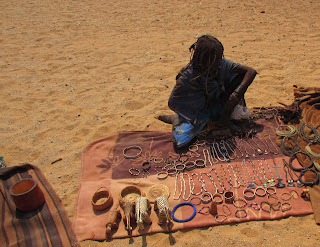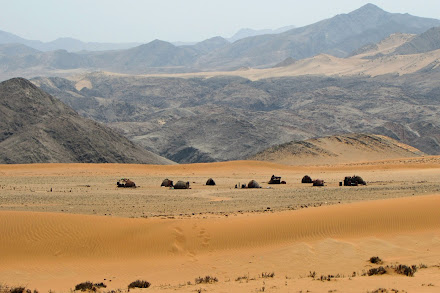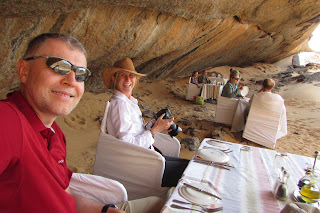Serra Cafema
Tuesday, Sept 1st
Our last camp in Namibia is Serra Cafema, which is located in the very Northwest of the country, right across the border with Angola and about 50 km from the coast. We had a direct flight from Ongava game reserve, which took just under two hours on a Cessna 210. While all of the airstrips we had been to so far were pretty remote, this one took it to a whole new level. We literally landed in the middle of the desert. There was absolutely no sign of civilization anywhere nearby. The airstrip was in an area called Hartmann's valley, a wide sandy valley with rocky mountains on either side. And in this totally empty and desolate place, there was a man in a truck waiting or us with a bottle of champagne:
There was almost no sign of any vegetation, just a few completely dry bushels of grass, and yet to our surprise again, we saw several Oryxes walking across the desert. These are huge animals that somehow manage to survive in this harshest of all landscapes.
 |
 |
The hour long drive to camp first took us across Hartmann's valley and then into the mountains and down a steep ravine into another wide desert valley. It was still a completely arid landscape, when suddenly around the next corner we saw this lush green strip of vegetation and the deep blue waters of a wide river below us. It was a totally unexpected almost mirage like sight in this landscape.
And what was equally surreal was the Serra Cafema camp itself, which turned out to be the most unbelievably luxurious camp imaginable. It is almost hidden among the trees right next to the river, and consists of several huts built entirely on stilts and connected by wooden walkways. There are eight guest cabins, which are enormous. Our hut was about the size of a three bedroom apartment in most cities, with a huge terrace deck in front of it overlooking the river. After settling into our 'villa', we went on a little hike up the dunes nearby for some great views of the camp and the river behind it. There are no large predators around this area, so it was safe for us to go walking by ourselves without for armed protection.
An amazing dinner was served on the deck surrounding the little pool, and the entire terrace was lit up with lots of little lanterns. It was not like we had not already felt incredibly spoiled in the previous three camps, but we already got the sense that Serra Cafema would take it luxury to a new level.
Wednesday, Sept 2nd
Today we visited a nearby Himba village. The Himba people are a semi-nomadic tribe, who live mostly from livestock farming. There are only an estimated 50,000 Himba people, mainly living in the Northwestern part of Namibia and on the other side of the Kunene River in Angola. Their diet consists of mainly meat and milk, with some maize and millet. Although they are ethnically identical to the Herera, they are culturally distinguishable and speak a slightly different dialect. One rather gruesome practice they perform to show their tribal identification and separate themselves from other tribes, is the practice of knocking out their two lower front teeth. This is done either with stones or wood to every child right around the age of ten.
The village we visited consisted of 10 tiny huts arranged in a circle. The huts are made of wood and cow dung, and are just large enough for 2 or 3 people to sleep in. Himba are polygamous, and each village like this has one dominant man, and his up to 6 wives.
The men in the village were all out herding sheep and cattle. They are usually away for weeks at a time, so only the women and children were here. We first had to be formally welcomed into the village. We greeted some of the elder women with a handshake, and then they welcomed us and allowed us to take their pictures. They were all very striking looking and beautiful women. They were all topless, only wearing animal skin skirts. Their entire bodies and hair are painted in red with a mixture of ochre and butter. Apart from cosmetic reasons, this also protects their skin from the sun and from mosquitoes.
They also spend an enormous amount of time and effort on their hair, which is elaborately styled using ochre and clay including fake hair extensions. Many of them also wear leather ornament headpieces, which we later learned are only worn by women once they are married or had children. Apparently it takes up to three days to do one lady's hair.
Several of the women were working on weaving beautiful baskets out of palm leaves. Some others were stirring pots over open fire, cooking what looked like some kind of porridge. Even though they were happy for us to take their pictures, it was interesting to see that almost none of them were making eye contact with us, and they never looked straight at the camera. Jeremia told us later that it is generally considered quite rude to look people straight in the eye.
The whole village was swarming with children of all ages. The little ones were playing and were particularly interested in Lara's camera. The slightly older children all seemed to be working, many of them weaving baskets.
We also learned that probably none of these women and almost none of the children went to school here. Even though the government is making a strong effort to get children from small villages into schools, it is apparently very difficult to persuade the Himba in particular to send their children to school, since they feel they get their children taken away from them when they do.
In front of one tent sat the matriarch and watched everything that was going on. We found out that she must be about 60 years old, but looked more like she was in her forties. No one around here knew how old their are, as ages or birthdays are not important.
We spoke for a while to the matriarch, and she seemed very concerned that neither of us was married or had children. Only when I told her that I had lots of nieces and nephews, she felt a little less sorry for me. We also asked her how many grandchildren she had, and she said two, but then we found out that she had one more grandson. However, she did not yet recognize the boy as her grandson, because her son had not married the mother and the boy had not yet been officially introduced to the village (even though both boy and mother lived in the hut right next to her). Apparently her son would have to pay several cattle to the brides family both for her and for her illegitimate son in order to be able to marry both of them and formally introduce them to his village.
Only after we had spent about an hour in the village, they opened their "shop" for us, which consisted of all the women spreading our in a circle and putting all of their handicraft in front of them. They had necklaces, bracelets, carved wood animals, weaved basket and some quartz stones. We tried to buy something from each of them and every time we handed over money, they clapped as a thank you.
This was a really interesting experience. I always feel a bit strange going into a tribal village like this and taking pictures. It just seems a bit like exploitation. But these women and children were clearly used to it, and they are getting something out of it. We bought lots of their handicraft, and the Serra Cafema camp works closely with all the villages around here and supports them. The most striking thing was how happy they all seemed. They could not be any poorer, and yet they were all laughing constantly with each other. I do wonder what they thought of us.
After the visit of the village, we drove further into the desert for about an hour and a half and we end up finding another extraordinary sight. Behind a small mountain right underneath an overhanging cliff were tables set up with white table clothes for our lunch. The staff from the camp had driven all the way out here, set up tables and a little kitchen in the most scenic spot they could find. There were six guests, and they cooked the most amazing three course lunch for us right here literally in the middle of the desert.
On our way back to camp we asked if we could do some hiking. So the car dropped us off some way away from the camp, and we hiked back to camp with Jeremia. It was a beautiful hike, which took about 1.5 hours. We started in the middle of a wide valley, crossed a couple of hills and then walked down into the river valley to our camp. We saw a family of baboons on the hill above us, a few oryxes in the distance and a couple of donkeys near the river.
Thursday, Sept 3rd
Our last day in Serra Cafema started with a boat ride along the river. The Kunene River originates in the Angolan highlands, and runs for 1,050 km first south to the Namibian border and then westwards to the Atlantic ocean. The river separates Namibia and Angola. The Angolan side looks to be much more mountainous, but also completely deserted with no sign of civilization.
There are rapids just down river from the camp, so we were only able to go upriver. We were in a little motor boat with Jeremia and our local guide Staintly (pronounced Stanley - they do have some weird names here. Two of the other men among the staff here are named 'Wanted' and 'Alpha'). It was a really beautiful and scenic trip up the river. We saw a few crocodiles along the way, but mostly small ones. Apparently there are some huge crocodiles in this river, and it is very dangerous for people to cross or even just get close to the shore to fetch water from the river. We also saw a group of baboons on the rocks and we came across a couple boys herding goats on the Angolan side.
We spent about an hour going upriver, and then did something that was technically illegal - we went ashore on the Angolan side and stepped onto Angolan soil. We had some drinks and enjoyed our half an hour as illegal immigrants in Angola. (I won't count it as having visited a new country though.)
Back at Serra Cafema they had set up lunch just for the two of us, on a little balcony on the far end of the camp with amazing views over the river. They really do go out of their way to set up special places for lunch and dinner here.
In the late afternoon, we went on a quad bike tour. After practicing a couple of laps we drove off into the desert following Staintly. Neither of us had ever ridden a quad bike before, and it was quite fun, but not as easy as it looked and at times it seemed a bit dangerous, since these were really powerful and fast vehicles.
We drove back to camp into the setting sun and had great views of the river coming in. And since it was our last night here, they again did something very special for us for dinner. They had set up a table surrounded by little paper lanterns on the porch in front of our own room, and they served us an amazing three course dinner, which was a very special way to celebrate our last evening in what was truly one of the most stunning and beautiful places we had ever seen.
___________________________________________________________________________________________
___________________________________________________________________________________________










































No comments:
Post a Comment